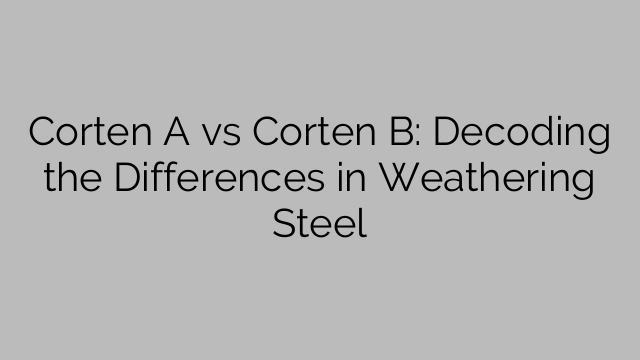To start, let’s discuss what weathering steel is and why it is valued in various industries. Weathering steel, also known as COR-TEN steel, is a type of steel alloy that develops a protective layer of rust when exposed to the elements. This layer acts as a barrier against further corrosion, thus eliminating the need for additional protective coatings. Weathering steel is highly resistant to atmospheric corrosion, making it a popular choice for outdoor structures such as bridges, buildings, sculptures, and decorative landscaping features.
Now let’s look at the differences between Corten A and Corten B. One of the main variations lies in their chemical composition. Corten A contains additional elements like copper, nickel, and chromium, which are known to enhance the weathering characteristics of the steel. These alloying elements promote the formation of a dense and stable rust layer, offering superior protection against moisture and other weathering factors. On the other hand, Corten B has a slightly lower percentage of these alloying elements, making it less resistant to corrosion than Corten A.
Another significant difference between Corten A and Corten B is their mechanical properties. Corten A has higher tensile strength and yield strength compared to Corten B, which means it can withstand greater forces and is less likely to deform under load. This makes Corten A a preferred choice for structural applications where strength is a critical factor, such as bridges and buildings. Corten B, with its lower strength properties, is often used for less demanding applications like decorative panels and architectural details.
Furthermore, the welding characteristics of Corten A and Corten B differ slightly. Corten A can be welded more easily than Corten B due to its higher phosphorus content, which improves the weldability of the steel. However, both types of weathering steel can be effectively welded using appropriate techniques and procedures.
When it comes to aesthetics, Corten A and Corten B have a dissimilar appearance. Corten A develops a more uniform rust color over time, offering a consistent and visually appealing patina. In contrast, Corten B tends to have a more varied and mottled rust appearance, which some designers find desirable for certain applications.
In summary, Corten A and Corten B are both types of weathering steel that offer excellent resistance to corrosion and are widely used in various construction and outdoor projects. Corten A has higher alloying elements and superior mechanical properties, making it suitable for structural applications requiring increased strength. Corten B, with its slightly lower alloy content, is often chosen for decorative and architectural purposes. Understanding the differences between these two types of weathering steel will help you make an informed decision about which one to use based on your specific project requirements.
[ad_2]

